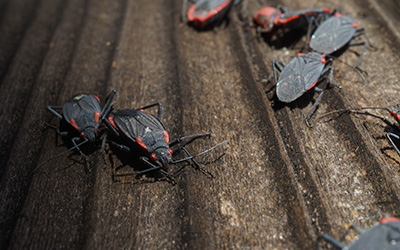
Boxelder bugs have become a common nuisance across the United States, and here in the Upper Midwest, it’s particularly bad. These invasive pests are easily recognizable by their distinctive red and black coloring, and while not harmful, they can be quite bothersome. Their nature to congregate means that you’ll often see many of them at the time, which, if you’re not fond of bugs, is an unpleasant sight, to say the least. To help you manage this seasonal pest, we’ve compiled expert tips on how to get rid of Boxelder bugs.
Read on to learn about what you should do if you think you might have Boxelder bugs in your Michigan home, including common DIY treatments, and how to tell Boxelders apart from stink bugs.
DIY Methods for Dealing with Boxelder Bugs
Boxelder bugs are harmless, which means that DIY removal is typically an option. There’s no risk to humans or pets, so you can get close enough to handle them. They’re also non-destructive, so time is not necessarily of the essence. If they don’t bother you, don’t worry about them. If you can’t stand them, give us a call and we’ll be happy to help.
If you want to try to take care of them yourself, you can try any of these methods:
- Gentle Removal: Boxelder bugs are slow, allowing for easy removal by trapping and releasing them outside. While this method is effective for individuals, it may not address large infestations.
- Squashing: If you feel like squashing a Boxelder bug, go ahead, but beware that they can release an odor that’s similar to stink bugs. The choice to squash or not depends on your tolerance for a temporary unpleasant smell.
- Vacuuming: A vacuum cleaner with an extender attachment can suck up Boxelder bugs, but be sure to empty the bag and throw everything away outside as they may climb out if not.
- DIY Traps: If you want to get creative, consider placing a tray with soapy water under a lamp. The light attracts the bugs, causing them to fall into the water and drown.
Need An Estimate for Boxelder Bug Control?
Caution with Indoor Pesticide Usage
If you’re fed up with Boxelder bugs and are considering using a store-bought pesticide in your home, be careful. Indoor pesticide usage can be unsafe unless handled by a trained professional, and they may not be entirely effective in eliminating the infestation. If you reach the point where you’re considering pesticides for Boxelder bugs, just call the residential pest control experts at Griffin instead.
When Are Boxelder Bugs Most Common?
Boxelder bugs are most active in the warm months, with spring marking their emergence. They lay eggs during the late spring and early summer and reach peak populations in late summer, persisting into the fall. Much like stink bugs, Boxelder bugs go dormant or die off in colder weather, making them a seasonal annoyance.
How to Tell the Difference Between Boxelder Bugs and Stink Bugs
Boxelder bugs and brown marmorated stink bugs are easily mistaken for each other due to their similar size and shape and emergence at similar times of the year. The ways to get rid of stink bugs are also fairly similar. The easiest way to tell the difference is by the coloring:
- Brown marmorated stink bugs: brown with beige to gray spots.
- Boxelder bugs: black with lines of striking red coloring.
Why Choose Griffin Pest Solutions for Seasonal Pest Control?
As Boxelder bugs continue to multiply across the Midwest, Griffin Pest Solutions is ready to assist. Our experienced boxelder bug exterminators are well-versed in the biology and behaviors of these common pests and know how to get long-lasting results. Whether you’re facing Boxelder bugs, stink bugs, or any other pest issues, Griffin Pest Solutions is your trusted partner in pest control. Call to schedule your treatment today!
Back to Seasonal Pest Control | Exterminators